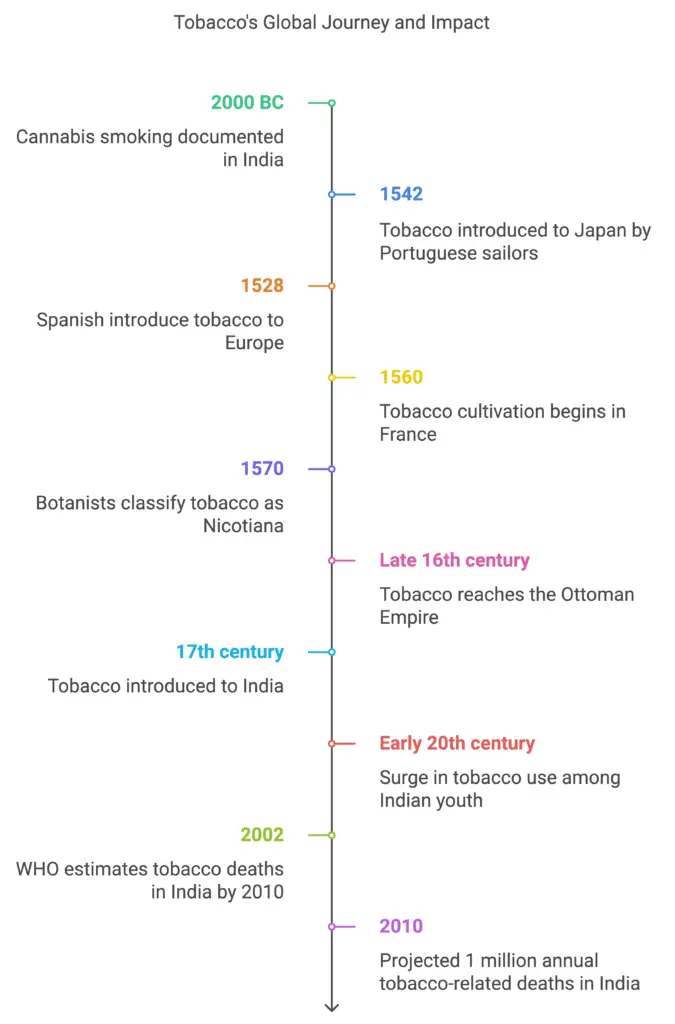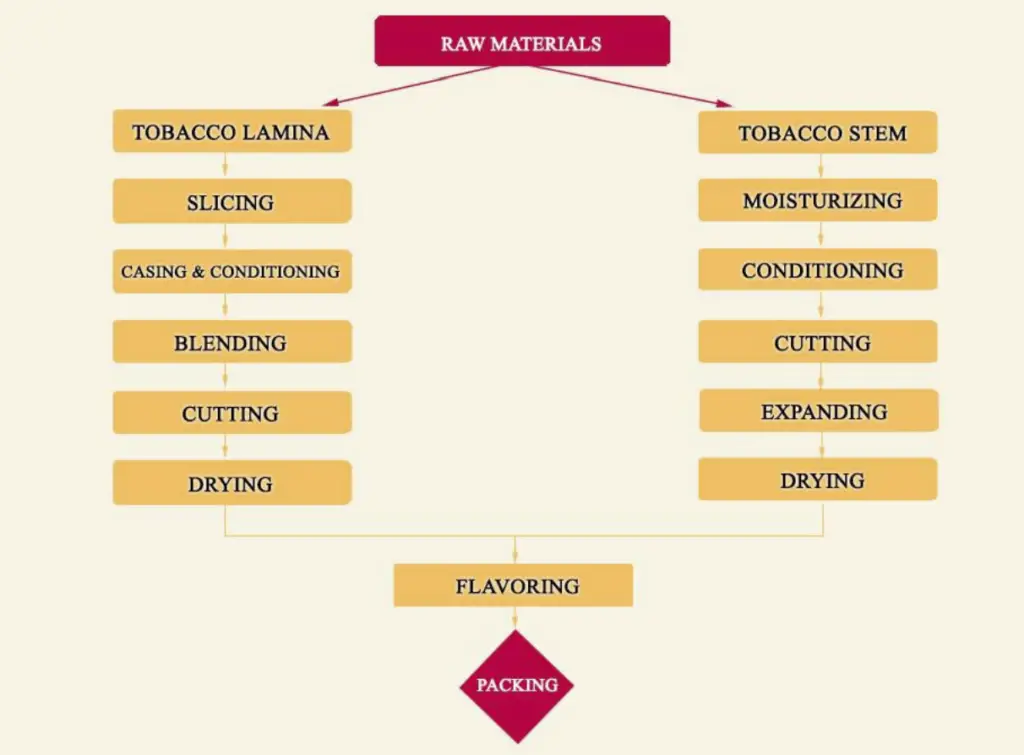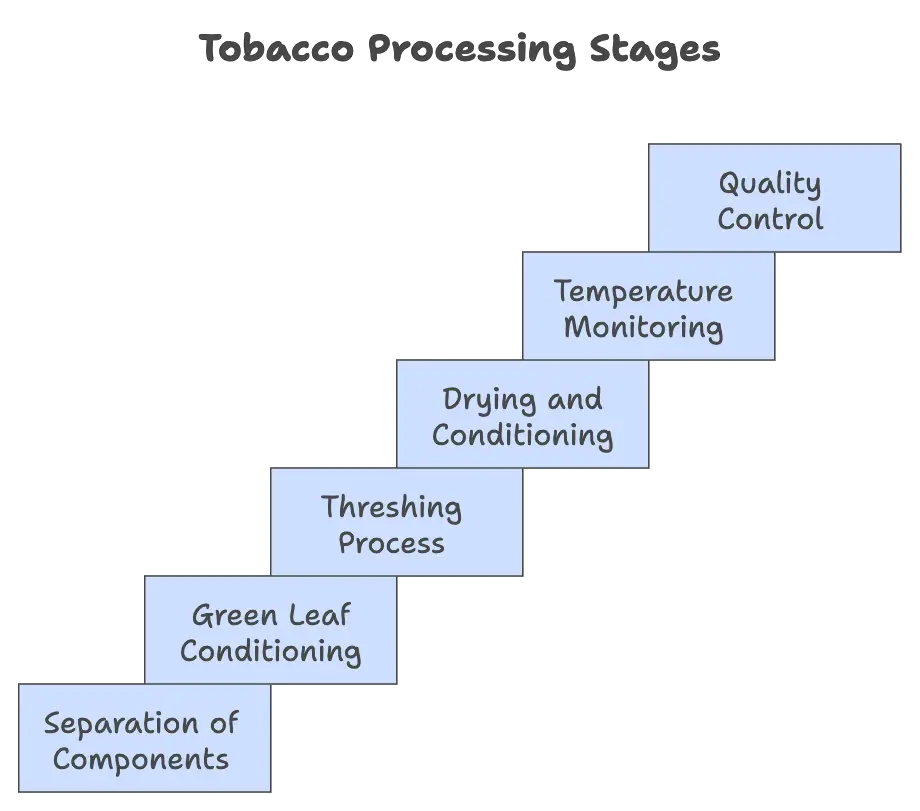Disclaimer: The information presented in this blog post about the tobacco plant is intended solely for educational purposes, particularly for botany students and enthusiasts. The content aims to provide a comprehensive understanding of the plant’s characteristics, uses, and cultivation methods. We do not endorse or promote the use of tobacco in any form, nor do we have any malicious intentions. It is important to recognize the health risks associated with tobacco use, and readers are encouraged to approach the topic with caution and responsibility.
What is Tobacco?
- Tobacco refers to various plants within the Nicotiana genus, which belongs to the Solanaceae family. Among the over seventy identified species, Nicotiana tabacum is the primary commercial variety cultivated for its leaves. Additionally, Nicotiana rustica, known for its higher nicotine content, is also grown and utilized in various regions globally. The significance of these plants extends beyond mere botanical classification; they are the source of a wide array of tobacco products.
- The primary psychoactive component found in tobacco is nicotine, a potent stimulant that has a high potential for addiction. In addition to nicotine, tobacco leaves also contain harmala alkaloids, which can contribute to the overall effects of tobacco consumption. Dried tobacco leaves are commonly prepared for various forms of consumption, including smoking in cigarettes, cigars, and pipes. Moreover, alternatives such as shisha, snuff, chewing tobacco, dipping tobacco, and snus have emerged as popular methods of intake, each carrying distinct cultural and social implications.
- The health risks associated with tobacco use are profound and well-documented. In 2008, the World Health Organization (WHO) identified tobacco as the leading preventable cause of death worldwide, underscoring its significant impact on global public health. The adverse effects of tobacco consumption include respiratory diseases, cardiovascular complications, and numerous forms of cancer, particularly lung cancer. Furthermore, secondhand smoke poses additional health risks to non-smokers, further complicating the public health narrative surrounding tobacco use.
- Efforts to reduce tobacco consumption have included educational campaigns, regulatory measures, and cessation programs aimed at mitigating its usage. Governments and health organizations worldwide continue to advocate for policies that discourage tobacco use, emphasizing the importance of prevention and education. Therefore, understanding the biological, cultural, and health-related aspects of tobacco is essential for developing effective public health strategies and promoting healthier choices among populations.
Origin of Tobacco
Tobacco’s history is rich and complex, deeply intertwined with the cultural practices of indigenous peoples in the Americas and its subsequent global diffusion. This narrative encapsulates its discovery, initial uses, and eventual spread across continents.

- Tobacco was first discovered by the native inhabitants of Mesoamerica and South America, where it had been utilized long before European contact. By the time European settlers arrived in the Americas, tobacco was already an integral part of the indigenous culture, used for various purposes, including ceremonial and medicinal practices.
- European knowledge of tobacco emerged only after the discovery of the New World. While Greek and Roman accounts mention the practice of smoking substances like hemp seeds and the energetic effects of lavender smoke, tobacco itself was entirely unfamiliar to Europeans until the late 15th century.
- The Spanish were pivotal in introducing tobacco to Europe, around 1528, subsequently making it a prominent product that fueled European colonization efforts. The cultivation of tobacco was not merely a matter of agriculture but also significantly impacted labor practices, notably leading to the incorporation of African slave labor in its production.
- In France, the cultivation of tobacco, referred to as herbe de la Reine or “the queen’s herb,” commenced in 1560. By 1570, botanists began to classify tobacco scientifically, designating it as Nicotiana, in honor of Jean Nicot, the French ambassador to Portugal who had popularized its medicinal use.
- Tobacco made its way to Japan in 1542, introduced by Portuguese sailors. The plant later reached the Ottoman Empire by the late 16th century, where it caught the interest of medical practitioners. Initially prescribed as a remedy for various ailments, further investigation led to reports of adverse effects, including dizziness and a foul taste or odor.
- In India, cannabis smoking has been documented since at least 2000 BC, with references in the Atharvaveda. Tobacco was introduced to India in the 17th century, eventually merging with existing smoking practices, predominantly those involving cannabis. By the early 20th century, tobacco use, particularly among the youth, surged to concerning levels, prompting widespread marketing and social discussions about its health implications.
- Statistics reveal that approximately 120 million smokers reside in India, constituting about 12% of the global smoking population, according to the World Health Organization (WHO). The prevalence of smoking among adult males in India is estimated at 70%, while among adult females, the figure remains lower, ranging from 13% to 15%. Alarmingly, a significant proportion of young people, around 90% of children under the age of 16, have experimented with some form of tobacco, with 70% continuing to use tobacco products.
- A 2002 WHO estimate projected that tobacco would account for 1 in 5 male deaths and 1 in 20 female deaths in India by 2010, predicting approximately 1 million annual fatalities attributable to smoking-related diseases. In Kolkata, a survey revealed a high smoking prevalence of 56.6%, with 82% of men and 23.5% of women identified as smokers. Uttarakhand reported the highest number of beedi smokers, indicating regional variations in tobacco consumption patterns.
Tobacco Types
Various types of tobacco are cultivated for specific uses, each characterized by distinct curing methods that influence their flavor, aroma, and application.

- Fire-Cured Tobacco: This type of tobacco is produced by exposing the leaves to smoke from open fires. The smoke penetrates the leaves, resulting in a darker color and a more pronounced flavor profile. Fire-cured tobacco is primarily used for snuff and chewing tobacco, where the robust taste is desirable.
- Dark Air-Cured Tobacco: As the name suggests, dark air-cured tobacco undergoes a process that relies on natural air drying without the influence of heat. This method results in a rich flavor and is specifically utilized for chewing tobacco, where the robust and distinctive taste is favored.
- Air-Cured (Maryland) Tobacco: This type of tobacco is also air-cured but is characterized by a lighter flavor profile compared to dark air-cured varieties. Maryland tobacco is primarily used for cigarettes, offering a milder taste that appeals to a broader audience.
- Air-Cured Cigar Tobaccos: These tobaccos are air-cured as well but are specifically selected for use as cigar wrappers and fillers. The air-curing process helps maintain the integrity and quality of the leaves, which are crucial for the overall smoking experience in cigars.
- Flue-Cured Tobacco: Flue-curing involves applying heat to the leaves in a controlled environment, ensuring that no smoke comes into contact with the leaves. This method preserves the natural sugars and flavors of the tobacco, resulting in a sweeter taste. Flue-cured tobacco is commonly used in cigarettes, pipes, and chewing tobacco due to its versatility and pleasant flavor profile.
- Burley Tobacco: Burley tobacco is another type that is air-cured, but it is known for its light color and mild flavor. It is frequently used in cigarettes, pipes, and chewing tobacco, making it a popular choice among consumers seeking a less intense smoking experience.
Morphology of Tobacco Plant
The morphology of the tobacco plant, particularly Nicotiana tabacum, is a vital aspect of its biology and contributes to its widespread cultivation and adaptation in various regions. This plant, considered to be of American origin, has been extensively introduced worldwide, demonstrating significant morphological diversity.
- Plant Structure: Nicotiana tabacum is characterized as an erect, stout herbaceous plant, which may exist as an annual or a short-lived perennial. It typically reaches heights of 1.5 to 2 meters. The stems are sparsely branched and covered with a viscid pubescence due to the presence of abundant glandular hairs, which can aid in deterring herbivores and retaining moisture.
- Leaves: The leaves of N. tabacum are notable for their size and texture. They are simple, alternate, and can be quite large, reaching up to 50 cm in length. Their shape varies from elliptic to ovate or obovate. The leaves generally decrease in size as they ascend the stem. The glandular pubescence covers the leaves, contributing to their coarse texture, while the margins can be either entire or undulate. The leaf apex is acute to acuminate, and the base exhibits a decurrent structure that wraps around the stem. The lower leaves feature winged petioles, while the upper leaves are typically subsessile, reflecting adaptations for maximizing sunlight exposure.
- Flowers: The floral arrangement of tobacco is distinguished by short, dense panicles. Each flower has pedicels ranging from 5 to 15 mm in length. The calyx is tubular, measuring between 12 and 20 mm long, with lobes that are narrowly triangular and acute, often unequal in size and shorter than the calyx tube. The corolla exhibits a salverform structure, with a limb that can be white, pink, or reddish, and consists of five lobes, forming a pentagonal shape with a diameter of 30 to 50 mm. The corolla tube is shorter and narrower than the throat cylinder, measuring 4 to 5 cm long, with a distinct cup-shaped throat.
- Stamens and Reproductive Structures: The stamens are unequal, with the upper four being longer than the fifth. They are inserted near the base of the corolla tube and are adnate to it for approximately 1 cm. The filaments measure between 2.5 and 4 cm in length and are pubescent at their bases. The fruit of the tobacco plant is a capsule that can be ellipsoid to ovoid in shape, equaling or exceeding the calyx and measuring 1.5 to 2.5 cm long.
- Seeds: Tobacco produces numerous seeds, which are approximately 0.5 mm long and exhibit a globose to oblong shape with a wavy reticulate testa. This seed morphology is essential for successful germination and establishment in various environments.
- Other Species: Nicotiana rustica, a smaller species compared to N. tabacum, typically grows to heights of 0.6 to 1.2 meters. This species often develops suckers, which are lateral shoots that can enhance its survival. The leaves of N. rustica are shorter yet thicker, broadly oval, and possess an uneven, puckered surface, contributing to its distinct morphological identity. The flowers of N. rustica display pale yellow to green hues, further differentiating it from N. tabacum.
Processing of Tobacco
The processing of tobacco involves a series of meticulously structured steps designed to prepare tobacco leaves for use in various products. This process transforms the freshly harvested leaves into a form that is suitable for storage and further manufacturing.

- Separation of Components: Whole tobacco leaves consist of a central stem, known as the midrib, and the leaf itself, referred to as the lamina. At the leaf processing facility, these components are mechanically separated since they are utilized independently during primary processing.
- Green Leaf and Stem Conditioning: Initially, harvested tobacco leaves undergo conditioning to enhance their pliability. This is achieved in conditioning cylinders, which are rotating drums equipped with independently controlled steam jet nozzles. These nozzles inject moisture into the tobacco, preparing the leaves for the subsequent mechanical threshing process. Conditioning plays a crucial role in facilitating the separation of lamina from the stem.
- Threshing Process: Following conditioning, the tobacco leaves enter a series of mechanical threshers. These machines employ thresher drums and blades to detach the lamina from the stems. The outcome of this process is a mixture that includes lamina, stems, and un-threshed leaves. This mixture is subsequently fed into a classifier, which effectively segregates the lamina from the un-threshed leaf and stem. The stem is then directed to the stem conditioning line, where it receives a higher moisture content than the green leaf, ensuring that it remains pliable for further processing.
- Drying: The lamina collected from the classifiers exhibits varying moisture levels; thus, it is essential to achieve uniform moisture content for proper storage. The lamina first passes through a drying chamber designed to equalize moisture content. Following this, the dried lamina is cooled before entering a high-humidity conditioning chamber, where it absorbs moisture until it reaches equilibrium. For safe storage and quality assurance, the ideal moisture level for both the lamina and stems is maintained between 11% and 12%. The lamina typically exits the drying chamber at around 6% to 8% moisture and reaches the final target level after conditioning. It is common practice to store the finished lamina and stems for a minimum of six months, allowing for aging or mellowing.
- Temperature Monitoring: Effective monitoring of the drying and conditioning processes is critical to ensure the desired outcomes. Real-time temperature monitoring can be employed as an additional measure alongside moisture control, enhancing the precision of the processing.
- Value and Quality Control: Throughout the tobacco leaf processing stages, moisture control remains a pivotal factor. Implementing a closed-loop process control system, such as the Process Sensors Corporation MCT460-T moisture analyzer, ensures optimal efficiency throughout the entire processing procedure. This approach aids in producing a consistent, high-quality end product that can be securely stored for months prior to its conversion into finished products at secondary processing plants.
- Conditioning Requirements: Efficient green leaf threshing (GLT) necessitates that the conditioned leaf maintains a moisture content between 17% and 22%. Accurate moisture measurement is vital to optimize the GLT process and attain the desired strand length for the lamina. Similarly, the stem is conditioned to approximately 40% moisture by controlling steam levels, which increases its pliability for cutting.

Uses of Tobacco
Tobacco, derived from the leaves of plants in the Nicotiana genus, has a multifaceted history of use, ranging from recreational to medicinal applications.
- Irritant Properties: When used as snuff, tobacco acts as a local irritant. This application can provoke intense sneezing and lead to an increased secretion of mucus. Additionally, when chewed, tobacco stimulates the flow of saliva by irritating the mucous membranes in the mouth, showcasing its effects on the oral cavity.
- Nicotine’s Physiological Impact: The alkaloid nicotine, a primary component of tobacco, is recognized as a potent poison. It exerts considerable influence on the digestive and circulatory systems, causing disturbances in these organs. Notably, nicotine innervates the heart, which can lead to symptoms such as palpitations, cardiac irregularities, and vascular contraction. It is also implicated in arterial degeneration, highlighting the significant health risks associated with its consumption.
- Historical Medicinal Use: Tobacco was historically utilized as a relaxant; however, its therapeutic use has diminished over time and is now limited. While it may occasionally be employed in the management of chronic asthma, this practice is not widespread. The active compounds in tobacco can be absorbed through the skin, posing serious health risks, including potential fatal outcomes.
- Medicinal Applications: Despite the risks, tobacco retains some medicinal uses. It has been employed as a sedative, diuretic, expectorant, discutient (a substance that helps dissolve or disperse), and sialagogue (a substance that promotes saliva production). Moreover, nicotine can serve as an emetic, although it is typically reserved for cases where other emetics have failed, indicating its powerful physiological effects.
Health Hazards of Tobacco
Tobacco use presents a myriad of health hazards, significantly impacting both individual health and public wellbeing. The range of diseases and conditions associated with tobacco consumption highlights the urgency for awareness and education on this subject.
- Cancer Risks: Tobacco is a well-established carcinogen linked to various forms of cancer, including but not limited to:
- Oropharyngeal cancers
- Laryngeal cancer
- Esophageal cancer
- Tracheal and bronchial cancers
- Lung cancer
- Acute myeloid leukemia
- Cancers of the stomach, liver, pancreas, kidney, and ureter
- Cervical cancer
- Bladder cancer
- Colorectal cancer
- Cardiovascular Diseases: The consumption of tobacco is a significant risk factor for heart disease and stroke. Nicotine and other harmful substances can lead to increased heart rate, elevated blood pressure, and the development of atherosclerosis, which collectively compromise cardiovascular health.
- Respiratory Diseases: Tobacco use is strongly associated with numerous lung diseases, which include:
- Emphysema
- Bronchitis
- Chronic airway obstruction
- Chronic obstructive pulmonary disease (COPD)
- Pneumonia
- Reproductive Health Effects: Tobacco usage poses serious reproductive health risks. The associated complications include:
- Ectopic pregnancy
- Premature birth
- Low birth weight
- Stillbirth
- Reduced fertility in women
- Erectile dysfunction in men
- Birth defects, such as cleft lip and/or cleft palate
- Additional Health Effects: Beyond the major health risks outlined, tobacco use is also linked to several other adverse health conditions, including:
- Type 2 diabetes
- Age-related macular degeneration
- Rheumatoid arthritis
- Blindness and cataracts
- Hip fractures
- Impaired immune function
- Periodontitis
Tobacco Leaf Harvesting, Curing, and Fermenting
The processes of harvesting, curing, and fermenting tobacco leaves are essential steps in producing high-quality tobacco products. Each stage has specific techniques that influence the flavor and quality of the final product, thereby making it critical for both students and educators to understand these processes comprehensively.
- Harvesting Tobacco Leaves:
- Tobacco can be harvested using two primary methods:
- The oldest method involves cutting the entire stalk at ground level with a curved knife.
- The more contemporary method, originating in the nineteenth century, involves “cropping” or “priming,” which entails pulling individual leaves from the stalk as they ripen. Since tobacco leaves ripen from the ground upward, this method allows for multiple harvests from the same plant.
- The first leaves to be harvested from the bottom of the stalk are referred to as “sand lugs,” as they are often dirty from contact with the soil.
- Tobacco can be harvested using two primary methods:
- Curing Tobacco Leaves:
- Curing is the drying process that prepares tobacco for consumption, and there are three main methods utilized, each suited to the type of tobacco being grown:
- Air-Cured Tobacco:
- This method involves hanging the tobacco leaves in well-ventilated barns, allowing them to dry naturally over four to eight weeks.
- Air-cured tobacco tends to have a low sugar content, which results in a light, smooth, semi-sweet flavor. These leaves typically have a high nicotine content.
- Flue-Cured Tobacco:
- In this method, the tobacco is strung onto sticks and hung in curing barns equipped with kilns.
- The barns feature flues connected to external fireboxes that provide heat without smoke, slowly raising the temperature during the curing process, which lasts about a week.
- Flue-cured tobacco is often used for cigarette production and is characterized by its higher sugar content, along with medium to high nicotine levels.
- Sun-Cured Tobacco:
- Predominantly sourced from countries like Turkey, Greece, and the Republic of Macedonia, sun-cured tobacco is dried naturally in the sun.
- This process yields a type of tobacco that is low in both sugar and nicotine, making it particularly popular for cigarette manufacturing.
- Air-Cured Tobacco:
- Curing is the drying process that prepares tobacco for consumption, and there are three main methods utilized, each suited to the type of tobacco being grown:
- Fermenting Tobacco Leaves:
- Fermentation, also known as sweating, is a crucial process that allows ammonia to be released from the leaves, enhancing their flavor and making them more palatable.
- This can be accomplished through two primary methods:
- Stacking:
- Used by larger growers, this method involves creating stacks of tobacco weighing about 100 pounds each, wrapped in burlap.
- The stacked tobacco is allowed to sweat, and the internal temperature is carefully monitored. When it reaches 140 degrees Fahrenheit, the stack is disassembled to release tar, ammonia, and nicotine.
- The process continues, with the stack being rebuilt multiple times until the internal temperature can no longer exceed 110 degrees. The stems are then stripped and stored in cooler conditions (around 65 degrees) for aging, which can last from six weeks to six years.
- Kiln Fermenting:
- This method is more suited for smaller growers who wish to smoke their harvest in a timely manner.
- The kiln is a small, insulated container with an artificial heat source that simulates fermentation. Tobacco leaves are placed inside, and the temperature (between 100 to 130 degrees) and humidity (65 to 70%) are meticulously controlled for 24 hours a day.
- The kiln fermentation lasts approximately four to six weeks, followed by a short aging period of four to six weeks or longer before the leaves can be processed into cigars, cigarettes, or pipe tobacco.
- Stacking:
Disclaimer: The information presented in this blog post about the tobacco plant is intended solely for educational purposes, particularly for botany students and enthusiasts. The content aims to provide a comprehensive understanding of the plant’s characteristics, uses, and cultivation methods. We do not endorse or promote the use of tobacco in any form, nor do we have any malicious intentions. It is important to recognize the health risks associated with tobacco use, and readers are encouraged to approach the topic with caution and responsibility.
- https://dacollege.org/uploads/stdmat/bot-Sem4-Drug-yielding-plants-2.pdf
- https://asutoshcollege.in/new-web/Study_Material/Eco_Bot_Drug_Yielding_Plants_05042020.pdf
- Text Highlighting: Select any text in the post content to highlight it
- Text Annotation: Select text and add comments with annotations
- Comment Management: Edit or delete your own comments
- Highlight Management: Remove your own highlights
How to use: Simply select any text in the post content above, and you'll see annotation options. Login here or create an account to get started.